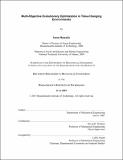Multi-objective evolutionary optimization in time-changing environments
Author(s)
Hatzakis, Iason
DownloadFull printable version (11.18Mb)
Other Contributors
Massachusetts Institute of Technology. Dept. of Mechanical Engineering.
Advisor
David R. Wallace.
Terms of use
Metadata
Show full item recordAbstract
This research is focused on the creation of evolutionary optimization techniques for the solution of time-changing multi-objective problems. Many optimization problems, ranging from the design of controllers for time-variant systems to the optimal asset allocation in financial portfolios, need to satisfy multiple conflicting objectives that change in time. Since most practical problems involve costly numerical simulations, the goal was to create algorithmic architectures that increase computational efficiency while being robust and widely applicable. A combination of two elements lies at the core of the proposed algorithm. First, there is an anticipatory population that helps the algorithm discover the new optimum when the objective landscape moves in time. Second, a preservation of the balance between convergence and diversity in the population which provides an exploration ability to the algorithm. If there is an amount of predictability in the landscape's temporal change pattern the anticipatory population increases performance by discovering each timestep's optimal solution using fewer function evaluations. It does so by estimating the optimal solution's motion with a forecasting model and then placing anticipatory individuals at the estimated future location. (cont.) In parallel, the preservation of diversity ensures that the optimum will be discovered even if the objectives motion is unpredictable. Together these two elements aim to create a well-performing and robust algorithmic architecture. Experiments show that the overall concept functions well and that the anticipatory population increases algorithm performance by up to 30%. Constraint handling methods for evolutionary algorithms are also implemented, since most of the problems treated in this work are constrained. In its final form the constraint handling method applied is a hybrid variant of the Superiority of Feasible Points, which works in a staged manner. Three different real-world applications are explored. Initially a radar telescope array is optimized for cost and performance as a practical example of a static multi-objective constrained problem. Subsequently, two time-changing problems are studied: the design of an industrial controller and the optimal asset allocation for a financial portfolio. These problems serve as examples of applications for time-changing multi-objective evolutionary algorithms and inspire the improvement of the methods proposed in this work.
Description
Thesis (Ph. D.)--Massachusetts Institute of Technology, Dept. of Mechanical Engineering, 2007. This electronic version was submitted by the student author. The certified thesis is available in the Institute Archives and Special Collections. Includes bibliographical references (p. 127-135).
Date issued
2007Department
Massachusetts Institute of Technology. Department of Mechanical EngineeringPublisher
Massachusetts Institute of Technology
Keywords
Mechanical Engineering.